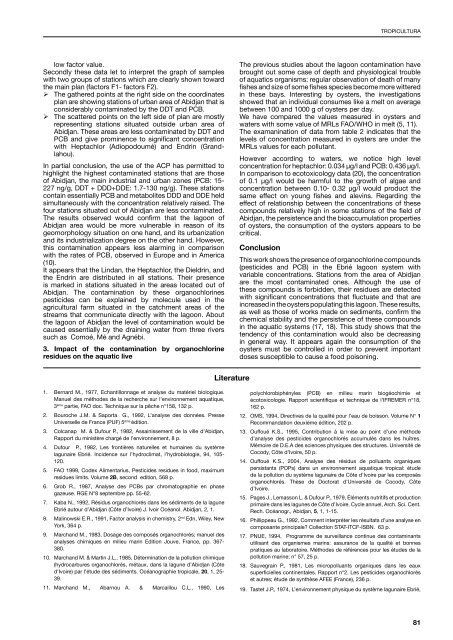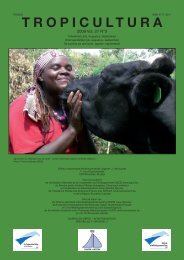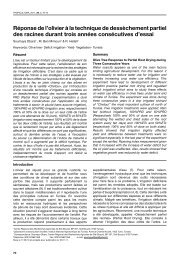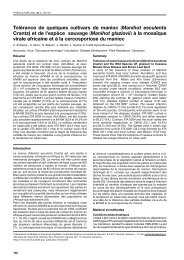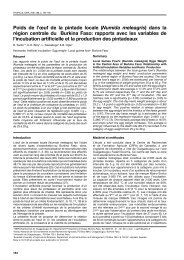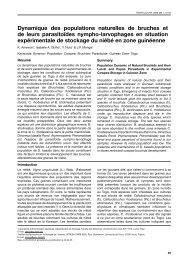Fascicule entier - Tropicultura
Fascicule entier - Tropicultura
Fascicule entier - Tropicultura
Create successful ePaper yourself
Turn your PDF publications into a flip-book with our unique Google optimized e-Paper software.
low factor value.<br />
Secondly these data let to interpret the graph of samples<br />
with two groups of stations which are clearly shown toward<br />
the main plan (factors F1- factors F2).<br />
<br />
<br />
The gathered points at the right side on the coordinates<br />
plan are showing stations of urban area of Abidjan that is<br />
considerably contaminated by the DDT and PCB.<br />
The scattered points on the left side of plan are mostly<br />
representing stations situated outside urban area of<br />
Abidjan. These areas are less contaminated by DDT and<br />
PCB and give prominence to significant concentration<br />
with Heptachlor (Adiopodoumé) and Endrin (Grandlahou).<br />
In partial conclusion, the use of the ACP has permitted to<br />
highlight the highest contaminated stations that are those<br />
of Abidjan, the main industrial and urban zones (PCB: 15-<br />
227 ng/g, DDT + DDD+DDE: 1.7-130 ng/g). These stations<br />
contain essentially PCB and metabolites DDD and DDE held<br />
simultaneously with the concentration relatively raised. The<br />
four stations situated out of Abidjan are less contaminated.<br />
The results observed would confirm that the lagoon of<br />
Abidjan area would be more vulnerable in reason of its<br />
geomorphology situation on one hand, and its urbanization<br />
and its industrialization degree on the other hand. However,<br />
this contamination appears less alarming in comparison<br />
with the rates of PCB, observed in Europe and in America<br />
(10).<br />
It appears that the Lindan, the Heptachlor, the Dieldrin, and<br />
the Endrin are distributed in all stations. Their presence<br />
is marked in stations situated in the areas located out of<br />
Abidjan. The contamination by these organochlorines<br />
pesticides can be explained by molecule used in the<br />
agricultural farm situated in the catchment areas of the<br />
streams that communicate directly with the lagoon. About<br />
the lagoon of Abidjan the level of contamination would be<br />
caused essentially by the draining water from three rivers<br />
such as Comoé, Mé and Agnébi.<br />
3. Impact of the contamination by organochlorine<br />
residues on the aquatic live<br />
1. Bernard M., 1977, Echantillonnage et analyse du matériel biologique.<br />
Manuel des méthodes de la recherche sur l’environnement aquatique,<br />
3ème partie, FAO doc. Technique sur la pêche n°158, 132 p.<br />
2. Bouroche J.M. & Saporta G., 1992, L’analyse des données. Presse<br />
Universelle de France (PUF) 5ème édition.<br />
3. Colcanap M. & Dufour P., 1982, Assainissement de la ville d’Abidjan,<br />
Rapport du ministère chargé de l’environnement, 8 p.<br />
4. Dufour P., 1982, Les frontières naturelles et humaines du système<br />
lagunaire Ebrié. Incidence sur l’hydroclimat, l’hydrobiologie, 94, 105-<br />
120.<br />
5. FAO 1999, Codex Alimentarius, Pesticides residues in food, maximum<br />
residues limits. Volume 2B, second edition, 568 p.<br />
6. Grob R., 1987, Analyse des PCBs par chromatographie en phase<br />
gazeuse. RGE N°8 septembre pp. 55-62.<br />
7. Kaba N., 1992, Résidus organochlorés dans les sédiments de la lagune<br />
Ebrié autour d’Abidjan (Côte d’Ivoire) J. Ivoir Océanol. Abidjan, 2, 1.<br />
8. Malinowski E.R., 1991, Factor analysis in chemistry, 2nd Edn, Wiley, New<br />
York, 364 p.<br />
9. Marchand M., 1983, Dosage des composés organochlorés; manuel des<br />
analyses chimiques en milieu marin Edition Jouve, France, pp. 367-<br />
380.<br />
10. Marchand M. & Martin J.L., 1985, Détermination de la pollution chimique<br />
(hydrocarbures organochlorés, métaux, dans la lagune d’Abidjan (Côte<br />
d’Ivoire) par l’étude des sédiments. Océanographie tropicale, 20, 1, 25-<br />
39.<br />
11. Marchand M., Abarnou A. & Marcaillou C.L., 1990, Les<br />
Literature<br />
TROPICULTURA<br />
The previous studies about the lagoon contamination have<br />
brought out some case of depth and physiological trouble<br />
of aquatics organisms: regular observation of death of many<br />
fishes and size of some fishes species become more wittered<br />
in these bays. Interesting by oysters, the investigations<br />
showed that an individual consumes like a melt on average<br />
between 100 and 1000 g of oysters per day.<br />
We have compared the values measured in oysters and<br />
waters with some value of MRLs FAO/WHO in melt (5, 11).<br />
The examanination of data from table 2 indicates that the<br />
levels of concentration measured in oysters are under the<br />
MRLs values for each pollutant.<br />
However according to waters, we notice high level<br />
concentration for heptachlor: 0.034 µg/l and PCB: 0.436 µg/l.<br />
In comparison to ecotoxicology data (20), the concentration<br />
of 0.1 µg/l would be harmful to the growth of algae and<br />
concentration between 0.10- 0.32 µg/l would product the<br />
same effect on young fishes and alevins. Regarding the<br />
effect of relationship between the concentrations of these<br />
compounds relatively high in some stations of the field of<br />
Abidjan, the persistence and the bioaccumulation properties<br />
of oysters, the consumption of the oysters appears to be<br />
critical.<br />
Conclusion<br />
This work shows the presence of organochlorine compounds<br />
(pesticides and PCB) in the Ebrié lagoon system with<br />
variable concentrations. Stations from the area of Abidjan<br />
are the most contaminated ones. Although the use of<br />
these compounds is forbidden, their residues are detected<br />
with significant concentrations that fluctuate and that are<br />
increased in the oysters populating this lagoon. These results,<br />
as well as those of works made on sediments, confirm the<br />
chemical stability and the persistence of these compounds<br />
in the aquatic systems (17, 18). This study shows that the<br />
tendency of this contamination would also be decreasing<br />
in general way. It appears again the consumption of the<br />
oysters must be controlled in order to prevent important<br />
doses susceptible to cause a food poisoning.<br />
polychlorobiphényles (PCB) en milieu marin biogéochimie et<br />
écotoxicologie. Rapport scientifique et technique de l’IFREMER n°18,<br />
162 p.<br />
12. OMS, 1994, Directives de la qualité pour l’eau de boisson. Volume N° 1<br />
Recommandation deuxième édition, 202 p.<br />
13. Ouffoué K.S., 1995, Contribution à la mise au point d’une méthode<br />
d’analyse des pesticides organochlorés accumulés dans les huîtres.<br />
Mémoire de D.E.A des sciences physiques des structures. Université de<br />
Cocody, Côte d’Ivoire, 50 p.<br />
14. Ouffoué K.S., 2004, Analyse des résidus de polluants organiques<br />
persistants (POPs) dans un environnement aquatique tropical: étude<br />
de la pollution du système lagunaire de Côte d’Ivoire par les composés<br />
organochlorés. Thèse de Doctorat d’Université de Cocody, Côte<br />
d’Ivoire.<br />
15. Pages J., Lemasson L. & Dufour P., 1979, Éléments nutritifs et production<br />
primaire dans les lagunes de Côte d’Ivoire. Cycle annuel, Arch. Sci. Cent.<br />
Rech. Océanogr., Abidjan, 5, 1, 1-15.<br />
16. Phillippeau G., 1992, Comment interpréter les résultats d’une analyse en<br />
composante principale? Collection STAT-ITCF-ISBN. 63 p.<br />
17. PNUE, 1994, Programme de surveillance continue des contaminants<br />
utilisant des organismes marins: assurance de la qualité et bonnes<br />
pratiques au laboratoire. Méthodes de références pour les études de la<br />
pollution marine; n° 57, 25 p.<br />
18. Sauvegrain P., 1981, Les micropolluants organiques dans les eaux<br />
superficielles continentales. Rapport n°2. Les pesticides organochlorés<br />
et autres; étude de synthèse AFEE (France), 236 p.<br />
19. Tastet J.P., 1974, L’environnement physique du système lagunaire Ebrié,<br />
81


